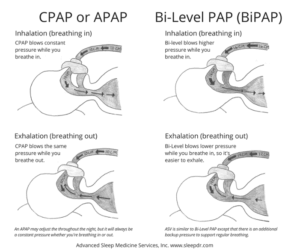BiPAP
Jan. 13, 2017
Did you know there are different types of PAP (Positive Airway Pressure) therapy? BiPAP which is also known as BiLevel is a common type of PAP therapy. This blog is going to talk about BiPAP and the difference between BiPAP and CPAP therapy.
CPAP machines deliver a steady, continuous stream of pressurized air to a patient’s airways to prevent them from collapsing and causing apnea events. One of the complaints about CPAP devices is that some patients find the constant singular pressure difficult to exhale against. For patients with higher pressure strengths, exhaling against the incoming air can feel difficult, as if they’re having to force their breathing out. BiPAP machines are often prescribed to sleep apnea patients with high pressure settings or low oxygen levels as well as people with lung disorders or certain neuromuscular disorders. The main difference between BiPAP and CPAP machines is that BiPAP machines have two pressure settings: the prescribed pressure for inhalation (IPAP), and a lower pressure for exhalation (EPAP).
BiPAP generates inspiratory (IPAP) and expiratory (EPAP) pressure gradients that complement the patient’s own respiratory cycle, optimising the lungs’ efficiency and reducing the work of breathing. BiPAP has been shown to be an effective management tool for COPD (Chronic Obstructive Pulmonary Disease) and acute and chronic respiratory failure. The difference in pressures helps to eliminate extra CO2 (carbon dioxide) gas from the body. This offers relief to the user’s typically overworked muscles of breathing. On some BiPAP units exhalation time is also set. COPD patients generally have long exhalation times due to loss of lung elasticity and setting exhalation time allows them exhale fully.
If you’ve tried CPAP and find the pressure settings too difficult to manage exhaling against, talk with your therapist at Cansleep to see if a BiPAP machine is right for you.
By Bahareh Ezzati (BSc, CPhT, RRT)






